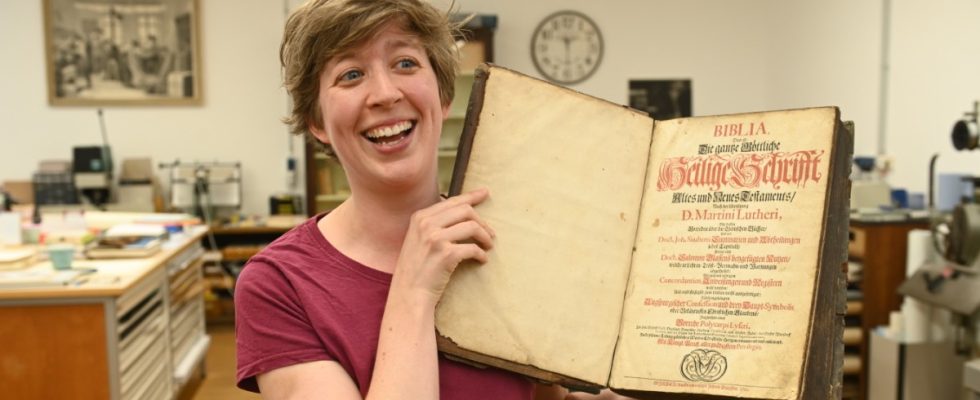The wooden book cover has splintered in many places, the cover is caked with dirt, and the paper pages have been left by mice and small tunnels. In short, this family Bible from 1719 shows that it was used diligently for centuries and passed on from generation to generation – until one day it ended up with Karen Wolter, who received the Bible from her grandmother. Wolter was already interested in the thick tome because of his job and took it with him to her workplace in the Deutsches Museum as visual aids.
Old but valuable piece: “You get a lot of dirt out of it.”
(Photo: Robert Haas)
“We get books like that here for restoration,” says Karen Wolter, while leafing through the family Bible – or through what’s left of it. The 32-year-old manages the bookbinding shop in the Deutsches Museum, where there are several work tables and equipment from the cutting machine to the printer in a small space. In order to restore the battered Bible, you first have to clean it carefully, says Karen Wolter – “Cleaning is the be-all and end-all for us”. For this you take small brooms, sponges and special erasers. “You get a lot of dirt out of it,” she says, and to prove it, lifts a jam jar full of dust and dirt that she got out of the book during a restoration. After cleaning, says Wolter, she then glues the breaks on the individual pages with glue and expensive Japanese paper.
All this time-consuming and often nerve-wracking fine work is usually done behind closed doors. On this Saturday, however, not only does the bookbindery open its doors to the general public, ten of the 24 work areas in the Deutsches Museum will open on the day of the open workshops. Then, in the electronics laboratory, among the mechanics and in the printing shop, visitors can get an idea of how the more than 70 craftsmen and artists restore exhibits and create new exhibits.
For example in the largest of all museum workshops, with the model builders, where a silver ball with a diameter of half a meter sits enthroned on a table just behind the entrance, vaguely reminiscent of the Death Star from “Star Wars”. In fact, however, this is a replica of the so-called “target chamber” of the laser fusion system of the National Ignition Facility (NIF) in California, where research is being carried out on nuclear fusion, explains Claus Grünewald. This model on a scale of 1:20 will one day be on display in the special exhibition “Light and Matter” – as a hands-on exhibit, which is why it is made of aluminum and plastic to make it “slightly more stable”, says the workshop manager. In order to recreate the target chamber as accurately as possible, a 3D design was first developed on the computer and then a preliminary model was made from polystyrene. The model builders could only have used a few photos as templates, says Grünewald. Because the NIF did not want to give out the top-secret construction plans.
Model maker Claus Grünewald with a historic miniature ice cream factory.
(Photo: Robert Haas)
You can also look over Elisabeth Strasser’s shoulder in her sculptor’s workshop.
(Photo: Robert Haas)
One table further shows that in the workshops of the Deutsches Museum not only new things are created, but also old things are preserved. There is a meter-long model of an ice cream factory from 1900, which clearly shows its age. Before this gem from the museum’s collection can be shown in the “Energy and Steam” exhibition from 2028, the model builders have to restore it extensively. “There’s also a row of pig halves,” says Claus Grünewald, opening a box in which the miniature models of the carcasses lie next to each other like sardines. “They have to end up in cold storage.”
Just one door next to the model builders you enter another workshop with high ceilings. The rushing of the Isar can be heard through the open window. There are all kinds of busts and sculptures on tables and in cupboards, dozens of jars with various substances are lined up on the shelves, and a postcard with a picture of an angel hangs on the wall. In addition the inscription: “Gypsum gives wings.” This has been the workplace of Elisabeth Straßer, head of the sculpture workshop, for 26 years.
What she loves most about her job, she says, “is the combination of science and how we translate it into our language”. Straßer and her two colleagues are also currently busy with the preparatory work for the special exhibition “Light and Matter”, which is scheduled to open in 2024. Among other things, they are working on five “scenarios”, as Straßer calls them. In other words, dioramas that include several showcase images and thus tell a story – for example about the invention of radar or the legendary debate on quantum mechanics between Niels Bohr and Albert Einstein.
For this purpose, the sculptors make small plaster figures of the researchers and combine them with original exhibits and backgrounds to tell an episode of the history of science in the style of a graphic novel. “With scenarios like this, we want to take away the fear of physics from the visitors,” says Elisabeth Straßer. “We’re not trying to explain it like a textbook. We’re telling the story.” And while you’re tinkering with this story, you can look over the shoulders of the sculptors on Saturday.
For the first time since 2019, the Deutsches Museum is organizing an open workshop day on Saturday, May 13th. These can be visited from 8 a.m. to 4 p.m. as part of 90-minute guided tours. Participation is free; Reservations can be made on the day of the event from 7.45 a.m.

